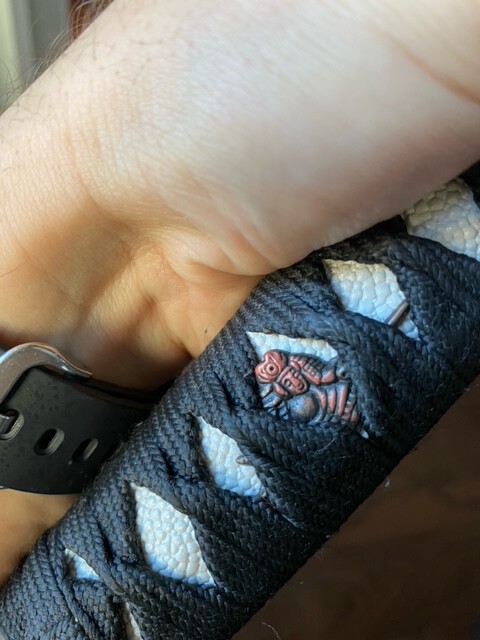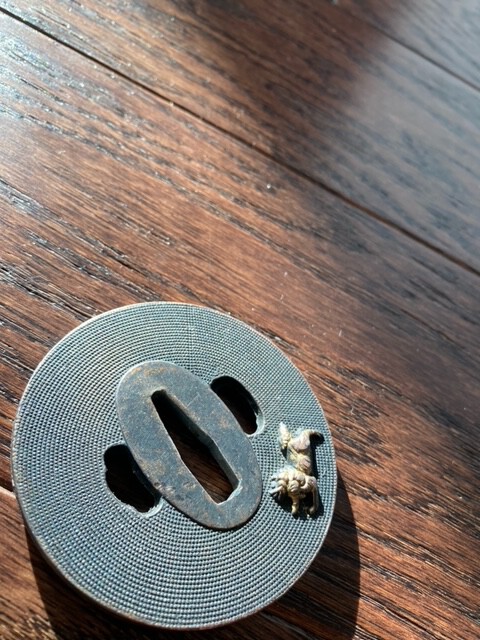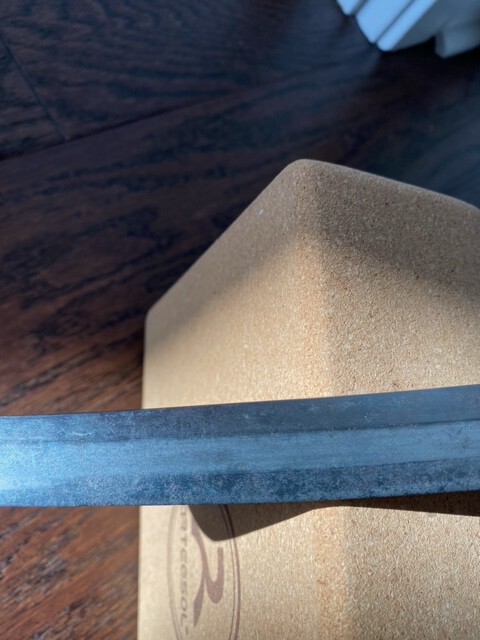
Tokugawa Gord
Members-
Posts
39 -
Joined
-
Last visited
Content Type
Profiles
Forums
Events
Store
Downloads
Gallery
Everything posted by Tokugawa Gord
-
Hello fellow collectors and enthusiasts. I am happy to announce a new addition to my collection, and I would ask for your help in identifying this beautiful blade. The blade feels heavy in the hand, and could use a new polish. I have done some research, and to me it appears to be a WW2 blade, with older fittings. The blade itself is reminiscent of later works by Chounsai Emura, a famous prison warden turned bladesmith during WW2. The hamon style is choji-midare with mixed in gunome-midare, which fits his style. Haagari nakago also fits the style. Emura tended to sign his blades, and this one does not have a signature, so I do believe this to be the work of one of his convicts, but perhaps an expert here could tell a different story. The hamon is The kissaki is ko-kissaki, and sharpened in the traditional way. The blade feels heavy in the hand, and will most definitely survive a new polish, I am now trying to figure out if it is worth polishing or not. The blade dimensions are: Nagasa: 22.25 Inches Curvature: 0.5 Inches The fittings that came with the blade are mixed, sa-me has fake ray-skin with older looking bronze menuki, with matching futchi, with an older looking Goto school tsuba with shi shi and peonies inlaid in a silverish/gold inlay. Traditional nanako-ji (fish egg) background. The blade and the tsuba may not match in age, but habaki looks original. Please any further help with identifying this blade would go a long way. Thank you all in advance! Warm Regards, Gordon S
-
Wakizashi Identification!
Tokugawa Gord replied to Tokugawa Gord's topic in General Nihonto Related Discussion
You were spot on. Upon finally removing the habaki, it was indeed cemented to the blade somehow. Pictures for your reference included. -
Wakizashi Identification!
Tokugawa Gord replied to Tokugawa Gord's topic in General Nihonto Related Discussion
Hello Stephen! It is with great excitement that I would like to announce that I managed to take off the habaki. It took some serious grit and pounding but here are the shots :). Let me know what you think. -
Wakizashi Identification!
Tokugawa Gord replied to Tokugawa Gord's topic in General Nihonto Related Discussion
Thank you so much Ken! I finally managed to take off the habaki, it was cemented on there pretty well (took a lot more than a piece of wood) . Find pictures without the habaki attached, and let me know your thoughts -
Wakizashi Identification!
Tokugawa Gord replied to Tokugawa Gord's topic in General Nihonto Related Discussion
Hello Christian, I have managed to finally pull off the habaki. Please find pictures attached, I think you are right. -
Wakizashi Identification!
Tokugawa Gord replied to Tokugawa Gord's topic in General Nihonto Related Discussion
Absolutely agreed, I am new to the site and already know that Ray is one of the experts . I think in this case, the seller may have just had the blade with no fittings, and slapped it together for quick sale to me. Thank you for being on team real! -
Wakizashi Identification!
Tokugawa Gord replied to Tokugawa Gord's topic in General Nihonto Related Discussion
Thank you Ray for circling back around, I am glad to hear the blade is real. Now I can get to work: ID smith, match the fittings to the period (I have a Goto school tsuba with shi shi and peonies), some umeghane filling, and new polish should do it. -
Wakizashi Identification!
Tokugawa Gord replied to Tokugawa Gord's topic in General Nihonto Related Discussion
Tried my best to tap, but it is indeed braised on there pretty tight. Will have to take it to a professional for a new habaki, polish and some umeghane filling. -
Wakizashi Identification!
Tokugawa Gord replied to Tokugawa Gord's topic in General Nihonto Related Discussion
Sounds great, will try later today and see if it budges! I also suspect a shortened katana. -
Wakizashi Identification!
Tokugawa Gord replied to Tokugawa Gord's topic in General Nihonto Related Discussion
Hello Stephen, thank you for your valued judgement. I am including a picture of the kissaki for your reference. Thank you for taking the time to assess. -
Wakizashi Identification!
Tokugawa Gord replied to Tokugawa Gord's topic in General Nihonto Related Discussion
Thank you Ray for your respectful opinion. Including a picture of kissaki and the space left between the tsuba for your reference. There is a 2cm space between the tsuba and habaki, indicating not original fittings, along with a piece of wood and electrical tape required to keep the blade in place with these fittings. Without the wood and the tape, the blade has no way of sitting in the hollow fitting. -
Wakizashi Identification!
Tokugawa Gord replied to Tokugawa Gord's topic in General Nihonto Related Discussion
I tried to pull it down, but it is in there very tight. I am trying not to risk damaging the blade, and I am unsure what tool to use to make it budge. Welcome to suggestions! -
Hello Everyone. I am a new collector of Japanese antique arms and armour. It is my pleasure to be part of this community, and i have read many posts here about Japanese swords and their smiths. I have an unidentified wakizashi I am struggling with, as it is not signed and is not in its original fittings. The hamon is similar to Bizen school, closest I found in geometry and hamon was Bishu Osafune Morimitsu. The reason I say that is the person I bought the sword from had other blades from the same school, particularly Bizen Osafune Sukesada. Some signed, some not. This particular one has no mei, but has some evidence of a clipped tang, which could help ID it. I notice some open kawagane, with visible shintetsu, which tells me the blade was polished many times. It is in good polish, still as sharp as it was polished and able to perform very well. The blade has obvious signs of action, with minor dents on the lower hamon, and an impact mark on the mune, but is in overall great condition with no fatal flaws. Any information on this wakizashi will help a long way, Japanese swords are a long time passion of mine, and I am so glad to have the opportunity to start this collection. I hope you all admire the ancient beauty as much as I do. Thank you in advance! Warm Regards, Gordon S









.thumb.jpeg.b251b1fec8d641b76ddc044e5c6bfad1.jpeg)
.thumb.jpeg.bf0a96c9f19320997328ef75e08334d5.jpeg)
copy.thumb.jpeg.73fe5efd69ac18c16cdcb50fcd4832f0.jpeg)
.thumb.jpeg.260a7376d032ee50a0e9179a94566210.jpeg)

.thumb.jpeg.24b7a745abdad70899f7b3b47134a4c2.jpeg)
.thumb.jpeg.0bdd0fdad160ee4281a74768ccd3a6dd.jpeg)
.thumb.jpeg.842c9d4450f0d8aee4378cdcb58da499.jpeg)
.thumb.jpeg.b43680171c9e896f910db1c93d0cce8f.jpeg)
.thumb.jpeg.550dd51ce0727749468466250fc4f9e3.jpeg)
.thumb.jpeg.6e2483b7f04edb0286ac8ab59e8d4f00.jpeg)
.thumb.jpeg.0218e6f89380259c93338cd673ec6611.jpeg)
.thumb.jpeg.bb4a166d552ec6c855803da2e4151d9f.jpeg)
.thumb.jpeg.6148b21f486dadf9951ce7af94eddb32.jpeg)
.thumb.jpeg.6ff6e0cc20189f6567af0918e50b838b.jpeg)
.thumb.jpeg.82bda961e1c494fbe11006c80b93f42c.jpeg)
.thumb.jpeg.e98e40a743a9ccb5e60a3c494d0dbfc4.jpeg)
.thumb.jpeg.0c74dce9d0636a26c0d6f1ad310d6b4d.jpeg)
.thumb.jpeg.79bd4b6dd75ccf294a059a77ae460de6.jpeg)
.thumb.jpeg.f396e8ab09f0e0d628eb94653474860f.jpeg)





.thumb.jpeg.53f83eb89b25bd73749f939a27915f7d.jpeg)




.thumb.jpeg.d2f568e7bf5f7b79fba8a304ab917f72.jpeg)
.thumb.jpeg.357722dfbc590cda0a25d09388393994.jpeg)
.thumb.jpeg.7d2d98f213eeca31b3a4ddceacc57576.jpeg)



